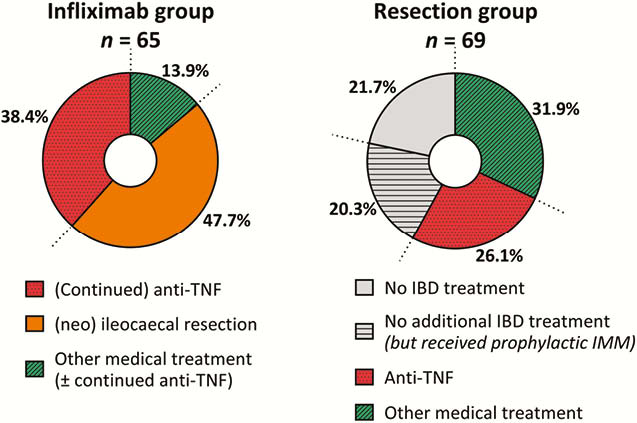OP03 Reduced need for surgery and medical therapy after early ileocaecal resection for Crohn’s disease: Long-term follow-up of the LIR!C trial
T. Stevens MD1, L. Haasnoot1, G. D’Haens1, C. Buskens2, E.J. de Groof2, E. Eshuis1, T. Gardenbroef3, B. Mol1, P. Stokkers3, W. Bemelman2, C. Ponsioen1, LIR!C
1Department of Gastroenterology and Hepatology, Amsterdam UMC- location AMC, Amsterdam, The Netherlands, 2Department of Surgery, Amsterdam UMC- location AMC, Amsterdam, The Netherlands, 3Department of Gastroenterology and Hepatology, OLVG, Amsterdam, The Netherlands
Background
The LIR!C trial showed that laparoscopic ileocaecal resection is at least as good as anti-TNF in terms of quality of life and is cost-saving. Current aims were to compare the long-term outcome of both interventions and to identify factors associated with the failure of the initial therapeutic strategy.
Methods
Long-term data were retrospectively collected for patients who participated in the LIR!C trial, a multicentre, randomised controlled trial that compared a laparoscopic ileocaecal resection with infliximab for adult patients with non-stricturing and immunomodulator refractory ileocaecal Crohn’s disease. Outcomes of interest needed for (re-)surgery or anti-TNF, duration of treatment effect as well as the identification of factors associated with sustained treatment effect. The treatment effect was defined as the time without the need for additional Crohn-related treatment. Potential factors were defined a priori and analysed by multivariable Cox regression analysis.
Results
Median follow-up time was 63.5 [IQR 39 – 94.5] months. In the resection group, 18 (26.1%) patients started anti-TNF treatment while none of the patients required a second resection (Figure 1). Twenty-nine (42%) patients did not require additional Crohn-related treatment. In contrast, in the infliximab group, 31 (47.7%) patients underwent a Crohn-related resection. Duration of treatment effect was similar with a median (95% CI) time without additional treatment of 33 (15.1–50.9) and 34 (0–69.3) months in the resection and infliximab group respectively (log-rank

Conclusion
This long-term follow-up study of the LIR!C trial showed that after a median follow-up of 5 years the majority of patients who underwent resection were free of anti-TNF treatment, none required a second resection and almost half were free of any additional medical treatment for disease flares. Conversely, almost half of the patients in the infliximab group moved on to a Crohn-related resection. These data support early ileocaecal resection in Crohn’s disease patients not responding to conventional treatment.


